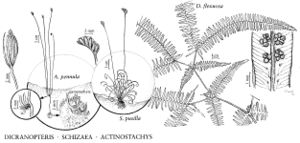Difference between revisions of "Schizaeaceae"
FNA>Volume Importer |
FNA>Volume Importer |
||
| Line 13: | Line 13: | ||
}}<!-- | }}<!-- | ||
| − | --><span class="statement" id="st- | + | --><span class="statement" id="st-undefined" data-properties=""><b>Plants </b>terrestrial or epiphytic. <b>Roots</b> numerous. <b>Stems</b> mainly erect, covered with many stiff hairs 1–3 cells long, with simple siphonostele (hollow vascular cylinder). <b>Leaves</b> tufted, monomorphic or dimorphic. <b>Petioles</b> much longer than blades, blades reduced to tiny apical fistlike or radiating groups of rudimentary fertile pinnae ("digits"). <b>Petioles</b> sometimes repeatedly dichotomous, in some species webbed between branches to form fan-shaped false blades. <b>Sporangia</b> arranged in 1–4 ranks on abaxial surface of digits with revolute margins. <b>Annulus</b> subapical, composed of 1–(2–3) layer(s) of thickened cells. <b>Gametophytes</b> subterranean and not green or borne aboveground and green, tuberlike or flattened, cordate or filamentous. <b>Spores</b> bilateral, monolete.</span><!-- |
-->{{Treatment/Body | -->{{Treatment/Body | ||
| Line 59: | Line 59: | ||
|publication year= | |publication year= | ||
|special status= | |special status= | ||
| − | |source xml=https://jpend@bitbucket.org/aafc-mbb/fna- | + | |source xml=https://jpend@bitbucket.org/aafc-mbb/fna-data-curation.git/src/9216fc802291cd3df363fd52122300479582ede7/coarse_grained_fna_xml/V2/V2_679.xml |
| − | |||
| − | |||
| − | |||
| − | |||
| − | |||
| − | |||
| − | |||
| − | |||
| − | |||
| − | |||
| − | |||
| − | |||
| − | |||
| − | |||
| − | |||
| − | |||
| − | |||
| − | |||
| − | |||
| − | |||
| − | |||
| − | |||
| − | |||
| − | |||
| − | |||
| − | |||
| − | |||
| − | |||
| − | |||
| − | |||
| − | |||
| − | |||
| − | |||
| − | |||
| − | |||
| − | |||
}}<!-- | }}<!-- | ||
-->[[Category:Treatment]] | -->[[Category:Treatment]] | ||
Revision as of 14:25, 27 July 2019
Plants terrestrial or epiphytic. Roots numerous. Stems mainly erect, covered with many stiff hairs 1–3 cells long, with simple siphonostele (hollow vascular cylinder). Leaves tufted, monomorphic or dimorphic. Petioles much longer than blades, blades reduced to tiny apical fistlike or radiating groups of rudimentary fertile pinnae ("digits"). Petioles sometimes repeatedly dichotomous, in some species webbed between branches to form fan-shaped false blades. Sporangia arranged in 1–4 ranks on abaxial surface of digits with revolute margins. Annulus subapical, composed of 1–(2–3) layer(s) of thickened cells. Gametophytes subterranean and not green or borne aboveground and green, tuberlike or flattened, cordate or filamentous. Spores bilateral, monolete.
Distribution
Nearly worldwide, mainly in tropical areas.
Discussion
Genera 2–3, species 30 (2 genera, 2 species in the flora).
Selected References
Lower Taxa
Illustrations
| Family ⠉ | Taxon | Illustrator ⠉ | |
|---|---|---|---|
 | Schizaeaceae Gleicheniaceae Schizaeaceae | Schizaea pusilla Dicranopteris flexuosa Actinostachys pennula | John Myers John Myers John Myers |
Key
| 1 | Fertile blades pinnate, segments arising along rachis on distal 3–10 mm; sterile leaves curling. | Schizaea |
| 1 | Fertile blades falsely digitate, segments appearing to arise at single point; sterile leaves absent. | Actinostachys |